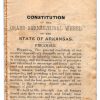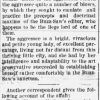calsfoundation@cals.org
National Farmers’ Alliance and Industrial Union of America
aka: Southern Farmers' Alliance
aka: Farmers' Alliance
aka: Arkansas State Farmers’ Alliance
The National Farmers’ Alliance and Industrial Union, more commonly known as the Southern Farmers’ Alliance (or simply the Alliance), began in the mid-to-late 1870s. The organization began spreading eastward through Arkansas and beyond in 1887. By the summer of 1890, it had expanded beyond the South and reported a membership of more than 1,200,000 in twenty-seven states. The Southern Farmers’ Alliance ran cooperative enterprises for its members and put forth a political platform. The group subsequently became active in the third-party movement that culminated in the formation of the People’s (or Populist) Party in 1891–92.
Origins and Growth
Farmers and stockmen formed the Southern Farmers’ Alliance in Lampasas County, Texas, as early as 1874 or as late as 1877, according to various sources. The group initially served as a social organization on the central Texas frontier. By the mid-1880s, the organization began forming cooperative enterprises to help its members sell crops and buy supplies on more advantageous terms. In August 1886, the Alliance put forth a political platform known as the Cleburne Demands, which focused on reform in land ownership, an increase in the money supply, and government regulation of railroads. In 1887, Alliance president C. W. Macune sent organizers into other southern states, including Arkansas, which received three organizers that spring. The Southern Farmers’ Alliance grew slowly in Arkansas, however, because the Agricultural Wheel—a native Arkansas farmers’ organization—already had a considerable presence in the state. Furthermore, Arkansas Alliance organizers did not coordinate their efforts effectively, and for a time two separate Arkansas State Farmers’ Alliance organizations existed until they consolidated at Little Rock (Pulaski County) on February 12, 1891. By then, the Farmers’ Alliance and the Agricultural Wheel had merged under the name of the former, not only in Arkansas but everywhere else where the two organizations had a presence.
The Colored Farmers’ Alliance
Unlike the Agricultural Wheel, the Southern Farmers’ Alliance did not accept African Americans as members. Thus a Colored Farmers’ Alliance began in Texas in 1886, and it followed the white Alliance across the South. The Colored Farmers’ Alliance sometimes worked in cooperation with the Southern Farmers’ Alliance, but tensions existed between the two organizations, especially since many members of the former worked as farm hands for members of the latter. This conflict of economic interests came to a brutal head in September 1891, when some African-American cotton pickers in Lee County walked off the job when the head of the Colored Alliance, R. M. Humphrey (a white Texan), called for pickers across the South to strike for higher wages. Most Colored Alliancemen heeded the warnings of white planters (including Southern Alliancemen) and stayed on the job, but the Lee County strike was crushed by a biracial posse (led by the white sheriff of the county) that killed at least fifteen African Americans. This tragic episode contributed significantly to the demise of the Colored Farmers’ Alliance by the end of 1892.
Demise and Legacy
Historians often point to the Southern Farmers’ Alliance as the major player in the formation of the People’s (or Populist) Party in 1891–92, but in Arkansas that party grew out of the earlier (and, in Arkansas, more successful) Union Labor Party. The Brothers of Freedom, the Agricultural Wheel, and the Knights of Labor all laid the foundation for that party in Arkansas before the Farmers’ Alliance even reached the state. The Southern Farmers’ Alliance nevertheless played a significant role in both the Union Labor and Populist parties in Arkansas, but the Alliance and the Populist Party were both finished in the state (and practically everywhere else) by 1900. Nevertheless, some of the political demands made by the Alliance and the Populists were soon adopted by Arkansas Democrats (most notably Jeff Davis, who served as governor from 1901 until 1907), and the bent of the Southern Farmers’ Alliance and the Colored Alliance for organizing tenant farmers and sharecroppers would be replicated in a racially integrated organization formed in Arkansas in 1934, the Southern Tenant Farmers’ Union.
For additional information:
Dunning, N.A., ed. The Farmers’ Alliance History and Agricultural Digest. Washington DC: Alliance Publishing Co., 1891.
Hild, Matthew. Greenbackers, Knights of Labor, and Populists: Farmer-Labor Insurgency in the Late-Nineteenth-Century South. Athens: University of Georgia Press, 2007.
———. “Labor, Third-Party Politics, and New South Democracy in Arkansas, 1884–1896.” Arkansas Historical Quarterly 63 (Spring 2004): 24–43.
Holmes, William F. “The Arkansas Cotton Pickers Strike of 1891 and the Demise of the Colored Farmers’ Alliance.” Arkansas Historical Quarterly 32 (Summer 1973): 107–119.
McMath, Robert C., Jr. Populist Vanguard: A History of the Southern Farmers’ Alliance. Chapel Hill: University of North Carolina Press, 1975.
Morgan, W. Scott. History of the Wheel and Alliance, and the Impending Revolution. 3rd ed. New York: Burt Franklin, 1968. First edition (1891) online at http://archive.org/details/historywheeland00morggoog (accessed February 7, 2024).
Matthew Hild
Georgia Institute of Technology






 Charles W. Macune
Charles W. Macune 



Comments
No comments on this entry yet.